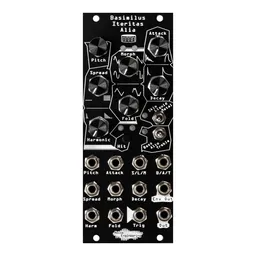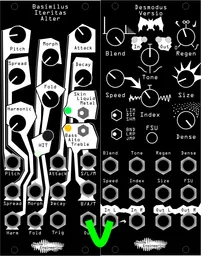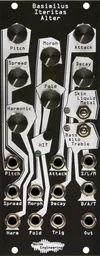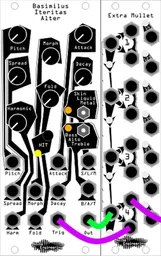Arrrrrrrrrr, matey! It be Talk Like a Pirate Week and we here in the captain’s quarters of the NE ship be celebratin’ in full swing! Itchin' t' be seein' how t' say somethin' in shipmate? Try this handy translator.
Yeah, okay, I can’t keep that up for a full post, but today we’ll but talking about two suitably pirate-y sequencers, Zularic Repetitor (ZR) and Numeric Repetitor (NR). Arrrgh.
Numeric Repetitor: for the more dance-inspired crewmember
NR is a wonderful rhythm generator, and while you can do a lot of things with it, its natural inclination is four-on-the-floor beats. In fact, turning everything down gives you quarter-note pulses on the first output and offbeat pulses on the second output. Patch up a kick and a clap and you’ve got some house.

The NR patterns, from the manual.
Take a look at these patterns. Each square represents an input beat, and each black square represents an output beat. The LEDs show which pattern is currently selected, so you can easily pick what you want!
Since the rhythms are controlled by CV-able knobs, you can easily start with a simple pattern like this, then twist in a new pattern to add some variation in a performance. Or, patch in a voltage sequence to automate the rhythmic variations. The knobs on these two modules actually act as attenuators, not offsets, so you can also patch in gates as control signals too and have easy control over what they do.
Check out NR in action in this rhythmic patch:
Learn more:
Here, we play some percussion using Cursus Iteritas Percido for the kick, Basimilus Iteritas Alter for the hats, and Manis Iteritas for the “clap”.
Zularic Repetitor: for funky pirates (and ninjas, too)
ZR, while functioning in a similar way to NR, takes its inspiration from a completely different place: actual music theory! Gasp. Fear not: you still just have to twist knobs to get cool rhythms and patterns. The patterns were developed from oldschool inspirations like Indian and African theory, and newer genres like rock and funk. Like NR, ZR is still plug and play though, so no matter how new to modular you are, or how long you’ve been at this, all you need to do is plug the module in to get cool patterns out.

Some of the ZR patterns, also from the manual.
The extra cool thing about both NR and ZR is that they follow any clock you send them. On both modules, steps only advance when they get a trigger at the Beat input. This means that you can feed in a swung clock and they’ll track perfectly! Extra funky. If you want it to play in sync with your whole patch, just send it 1/16th note pulses and it’ll follow along perfectly.
One of my favorite things to do with NR and ZR is to trigger the voices in a polyphonic patch with them. Even something simple like a four note chord can become interesting when triggered with nice rhythms. Check that out in this patch:
Here, we use ZR to trigger three voices, which are pitch sequenced by Mimetic Digitalis. Cursus Iteritas Percido, Basimilus Iteritas Alter, and Loquelic Iteritas Percido are the actual voices.
What if I want to use BOTH NR AND ZR at the SAME TIME??
You’re in luck! We make two modules that’re great for that sort of thing. Meet Confundo Funkitus and Integra Funkitus.
Integra Funkitus has four trigger/gate ins and outs. It has three different modes, but one of them lets you combine the inputs in different ways. For instance, if you want inputs 1, 3, and 4 to be mixed and output on channel 1, you can do that! Just turn channel 1’s knob to the correct position. It also has a probability mode, so if you’re using ZR or NR, you can change the likelihood that a trigger will actually happen on a particular step.
Confundo Funkitus, on the other hand, has 8 inputs, 4 outputs, mutes, and a crossfader. Each channel has a left and a right trigger input, and the crossfader lets you mix between the two inputs. Think of it like a DJ mixer, but instead of mixing two tracks with the crossfader, you’re mixing two trigger patterns. Plus, each channel has a mute, so it’s very performable. ZR+CF+NR is a super super fun module combo. Check this out:
Here, we’ve got two sets of rhythms from NR and ZR, and Confundo Funkitus mixes them together and keeps things interesting. The kick is from Cursus Iteritas Percido again, hats are from Basimilus Iteritas Alter, and the synth is Loquelic Iteritas Percido.
Thinking outside the box: modulation
NR and ZR output triggers. However, since triggers are just voltage, we can use them for modulation, too! Check out this patch with NR modulating Cursus Iteritas:
One of my favorite uses for it, though, is to use it to trigger something like Pons Asinorum to create rhythmic envelopes. Rhythmic modulation can make a patch much more interesting.
In conclusion: Arrrrrrrrgh
Shiver me timbers! NR and ZR are both simple-to-use but complex-sounding rhythms generators. They’re both very performable and immediate, and easy to fit into a performance case. We promise they’ll appeal to any pirates in your life.






